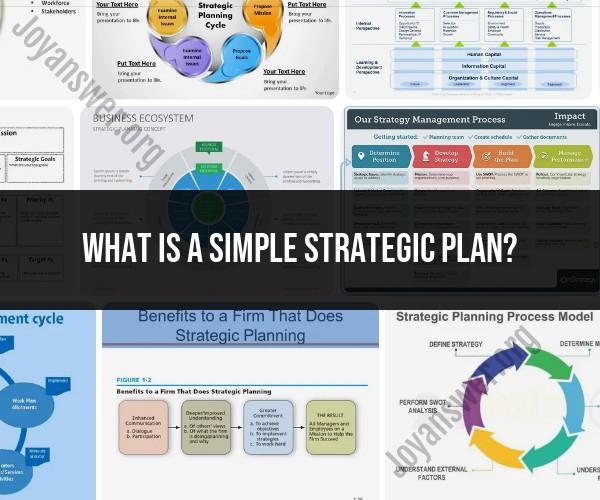What is a simple strategic plan?
A simple strategic plan is a streamlined and concise document that outlines an organization's high-level goals, objectives, and strategies for achieving its mission or vision. Unlike more comprehensive strategic plans that may be used by large corporations, simple strategic plans are often designed for smaller businesses, startups, non-profit organizations, or teams within larger organizations. They provide a clear roadmap for the organization's future without the complexity and detail of a full-scale strategic plan. Here's a step-by-step guide to creating a simple strategic plan:
1. Define Your Purpose and Scope:
- Start by clarifying the purpose of the strategic plan. What do you hope to achieve with this plan, and who is the intended audience? Determine the scope, such as whether it covers the entire organization or a specific department or project.
2. Conduct a SWOT Analysis:
- Perform a SWOT analysis to identify your organization's internal strengths and weaknesses, as well as external opportunities and threats. This analysis will inform your strategic planning process.
3. Set Clear Objectives:
- Define specific, measurable, achievable, relevant, and time-bound (SMART) objectives that align with your organization's mission and address the findings from your SWOT analysis. Objectives should answer the question, "What do we want to achieve?"
4. Identify Key Strategies:
- Determine the broad strategies or approaches you will use to accomplish your objectives. These strategies should outline the general direction you plan to take. For example, if one of your objectives is to increase market share, a key strategy might be "expand into new geographic markets."
5. Create Actionable Initiatives:
- Break down each strategy into actionable initiatives or projects. Initiatives should describe the specific steps, tasks, and resources required to implement the strategy. Assign responsibility for each initiative to individuals or teams.
6. Define Key Performance Indicators (KPIs):
- Establish KPIs to measure progress toward your objectives. KPIs should be specific, measurable, and tied to your objectives. They provide a way to track success and make data-driven decisions.
7. Develop a Timeline:
- Create a timeline or project plan that outlines when each initiative will be launched, the expected duration, and key milestones or deadlines. This helps ensure accountability and keeps the plan on track.
8. Allocate Resources:
- Determine the resources (financial, human, technological) needed to execute the initiatives successfully. Make sure you have the necessary resources in place or have a plan to secure them.
9. Monitor and Review:
- Regularly monitor progress against your KPIs and review the strategic plan's effectiveness. Use this feedback to make adjustments as needed and adapt to changing circumstances.
10. Communicate and Engage:- Share the simple strategic plan with relevant stakeholders, including employees, board members, or team members. Ensure that everyone understands the plan's objectives and their roles in achieving them.
11. Keep It Concise:- Keep the plan concise and easy to understand. Focus on the most critical goals and strategies to avoid overwhelming stakeholders with unnecessary detail.
A simple strategic plan should be a living document that guides decision-making and actions within the organization. It should be revisited and updated periodically to ensure that it remains aligned with the organization's goals and evolving priorities.











